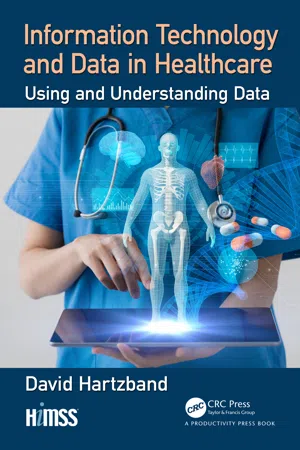
Information Technology and Data in Healthcare
Using and Understanding Data
David Hartzband
- 172 pagine
- English
- ePUB (disponibile sull'app)
- Disponibile su iOS e Android
Information Technology and Data in Healthcare
Using and Understanding Data
David Hartzband
Informazioni sul libro
Healthcare transformation requires us to continually look at new and better ways to manage insights – both within and outside the organization. Increasingly, the ability to glean and operationalize new insights efficiently as a byproduct of an organization's day-to-day operations is becoming vital for hospitals and health systems to survive and prosper. One of the long-standing challenges in healthcare informatics has been the ability to deal with the sheer variety and volume of disparate healthcare data and the increasing need to derive veracity and value out of it.
This book addresses several topics important to the understanding and use of data in healthcare. First, it provides a formal explanation based on epistemology (theory of knowledge) of what data actually is, what we can know about it, and how we can reason with it. The culture of data is also covered and where it fits into healthcare. Then, data quality is addressed, with a historical appreciation, as well as new concepts and insights derived from the author's 35 years of experience in technology.
The author provides a description of what healthcare data analysis is and how it is changing in the era of abundant data. Just as important is the topic of infrastructure and how it provides capability for data use. The book also describes how healthcare information infrastructure needs to change in order to meet current and future needs. The topics of artificial intelligence (AI) and machine learning in healthcare are also addressed. The author concludes with thoughts on the evolution of the role and use of data and information going into the future.
Domande frequenti
Informazioni
Chapter 1
Introduction – Data Is Essential
- Enhancing patient experience
- – There are two major aspects to enhancing the patient’s experience: first is improving the healthcare outcome for the patient and second is improving how the patient and their family, caregivers, etc., experience the interaction with the healthcare establishment (doctors, other providers, hospitals, health centers, other treatment facilities, etc.). Improving outcomes requires access to and analysis of the patient’s clinical data in order to do diagnosis, treatment planning, care coordination, and all the other things that constitute care.
Improving the patient’s and their family’s and caregiver’s experiences requires the communication of data so that all parties have the information they need to interact with the healthcare professionals providing care and to make the necessary decisions. This communication facilitates the trust that’s needed in order for the entire healthcare experience to be improved for all parties.
- – There are two major aspects to enhancing the patient’s experience: first is improving the healthcare outcome for the patient and second is improving how the patient and their family, caregivers, etc., experience the interaction with the healthcare establishment (doctors, other providers, hospitals, health centers, other treatment facilities, etc.). Improving outcomes requires access to and analysis of the patient’s clinical data in order to do diagnosis, treatment planning, care coordination, and all the other things that constitute care.
- Improving population health
- – Addressing population health requires:
- Identifying specific populations
- Stratifying the individuals in the population with respect to the prevalent healthcare risks
- Planning and executing interventions to reduce those risks and improve individual outcomes
This is not possible without access to comprehensive data about the population(s) and the analysis of this data in order to identify and stratify risks.
- – Addressing population health requires:
- Reducing costs
- – Clinical and financial data need to be analyzed together in order to determine the cost of care (per capita and along other dimensions such as per provider, per location, etc.). These results can then be used to plan cost reduction measures as well as compare costs over time in order to define the trend in costs.
- Improving the work life of providers
- – Data is also important in determining work and life conditions for providers and then in planning changes and/or interventions to improve the quality of their work life.
Chapter 2
What Is Data?
- Factual information (such as measurements or statistics) used as a basis for reasoning, discussion, or calculation
- Information in digital form that can be transmitted or processed
- Information output by a sensing device or organ that includes both useful and irrelevant or red...
Indice dei contenuti
- Cover
- Half-Title
- Title
- Copyright
- Dedication
- Publisher’s Note
- Contents
- Preface
- About the Author
- 1 Introduction – Data Is Essential
- 2 What Is Data?
- 3 Data and Culture
- 4 Data Quality
- 5 What Is Data Analysis?
- 6 The Evolution of Infrastructure and Applications Required for Current and Near-Future HIT
- 7 Machine Intelligence in Healthcare
- 8 Evolution of Data and Analysis in Healthcare
- 9 Summary
- Index